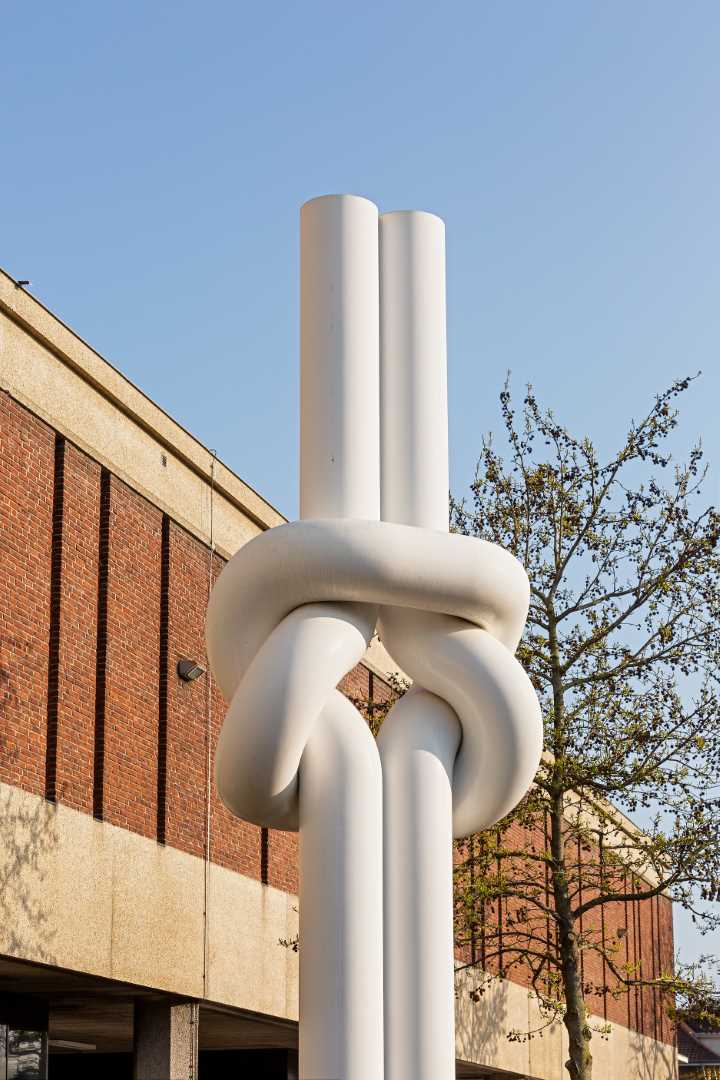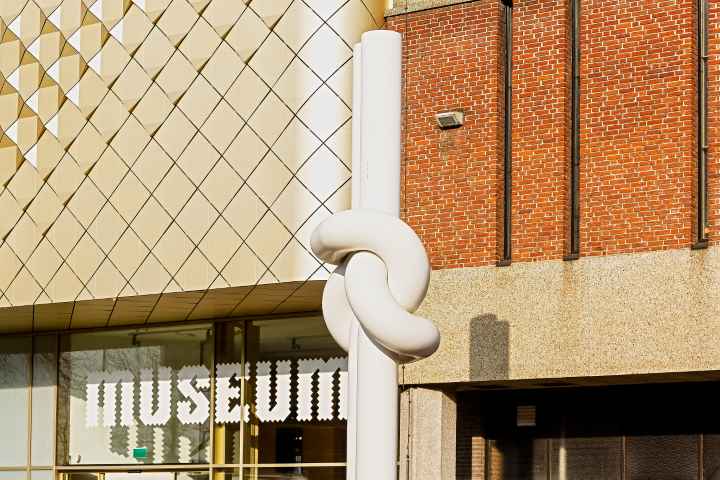Square knot
Keulsepoort
Square knot (the knot) – Shinkichi Tajiri
Square knot, one of the famous knots by the artist Tajiri, has been at Museum van Bommel van Dam since 1993 – firstly at the building on the Deken van Oppensingel; in 2021 it moved a few hundred metres to the museum’s new home in the former post office. For years, the artist made various versions of this type of button. His explanation was: “I want people to be able to give their own meaning to my works of art. With my ‘buttons’, I want to make a clear statement, ensure immediate communication between the work and the viewer.”
His often metres-high ‘knots’ made of bronze, cast iron, steel or plastic can be seen at numerous locations around the world and sometimes function as arches or gates. He created the button sculptures as a response to conceptual art in which, according to the artist, many words are needed to explain something. Tajiri did not like that art. “The general public doesn’t understand it either. With my buttons, I wanted to make a statement that everyone would understand. Knots are of all ages. The beauty of the knot is the harmony between simplicity and strength.”
In 1981, the same Square Knot, the Friendship Knot, as the one in Venlo at Museum van Bommel van Dam, was placed in Little Tokyo, Los Angeles and Tajiri was presented with the key to the city as an honorary citizen.
The artist: Shinkichi Tajiri
Shinkichi George Tajiri (Los Angeles, 7 December 1923 – Baarlo, 15 March 2009) was a Dutch-American artist of Japanese origin. Besides being a sculptor, he was a painter, photographer and filmmaker. He received his first sculpture lessons in 1940. Two years later, after the Japanese attack on Pearl Harbour, Tajiri was imprisoned along with many other Americans of Japanese descent. A year later, he volunteered for the 442nd Regimental Combat Team, a unit composed solely of Japanese-Americans – for which he posthumously received the Congressional Gold Medal from President Obama. Tajiri was sent to Italy where he was wounded.
After the war, Tajiri decided to leave the United States because of the poor treatment of his people. He first settled in Paris where he studied with Ossip Zadkine, Fernand Léger and then at the Académie de la Grande Chaumière. In the mid-1950s, he met the Dutch sculptor Ferdi Jansen from Arnhem, with whom he moved to Amsterdam in 1956. In 1962, the family, which by then had two daughters, settled in Scheres Castle in Baarlo, near Venlo.
In 1949, Tajiri had come into contact with the COBRA group with whom he exhibited in the Stedelijk Museum in Amsterdam. In 1951, the second international exhibition of experimental art (COBRA) was held in Liège. He participated in both exhibitions and was the only one representing the USA. His first exhibition after settling in the Netherlands in 1956 took place at the country estate Hofwijck in Voorburg. In 1959, together with Wessel Couzijn, Hans Verhulst, Ben Guntenaar and Carel Kneulman, he founded the Group Adam. From 1969 to 1989, he was a professor at the Hochschule der Künste in Berlin.
On 25 June 2005, Tajiri was appointed honorary citizen of the municipality of Maasbree and on 7 December 2007 he was knighted in the Order of the Dutch Lion, because of his exceptional dedication and the cultural-historical significance of his activities. In December 2008, shortly before his death, Shinkichi Tajiri received Dutch citizenship.
De Keulsepoort (The Keulse Gate)
As one of the four main gates, the Keulsepoort was part of the fortifications of the city of Venlo (built between 1340 and 1345). In the 19th century, these fortifications – like those of many other Dutch cities – became so constricted that it was decided to demolish them. That happened between 1867 and 1872. Work at the site in 2011 revealed that the foundations of the gate are still intact underground.
After the city walls were demolished, the Köln-Mindener railway line was built at Cologne Gate and what is now the (adjacent) Juliana Park. This was a German railway line that was part of the Hamburg-Paris route. Just before the Second World War, near the foundations of the Keulsepoort, the building was constructed that served as a post office for a very long time, but nowadays houses the Van Bommel van Dam Museum.
The railway track disappeared after the war and was replaced by Julianapark. After that, the Keulsepoort was one of the access roads for car traffic to the inner city for several decades.
That road was closed off at the end of the last century, after which the Keulsepoort became a square. In 2000, the Limburgs Museum was built on that square, and in 2021, the Van Bommel van Dam Museum opened its doors in the adjacent, former post office, after having been located on the Deken van Oppensingel, a few hundred metres away, for about fifty years.
That building was specially built for the museum and also housed the two founders, Maarten and Reina van Bommel-van Dam. In 2021, a start was also made on the redevelopment of the Keulsepoort, which has been given a greener character, among other things. Because of the presence of the two museums, the Keulsepoort is often called Museumplein in popular speech. Opposite the Limburgs Museum is a building that was originally one of the oldest and perhaps the oldest petrol stations in the Netherlands. It dates from 1933 and belonged to the American Petroleum Company (later Esso). Nowadays, one can eat some ice cream there.





